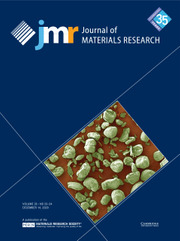Article contents
Secondary ion mass spectrometry study of Ti4+ diffusion properties in congruent Er:LiNbO3 codoped with moderate concentration of MgO
Published online by Cambridge University Press: 31 January 2011
Abstract
At 1100 °C, the diffusion properties of Ti4+ into congruent LiNbO3 crystals codoped with 0.5 mol% Er2O3 and different MgO concentrations of 0.5, 1.0, and 1.5 mol% have been studied by secondary ion mass spectrometry (SIMS). Three Y-cut and three Z-cut plates with different Mg doping levels were coated with a 60-nm-thick Ti film at first and then annealed at 1100 °C for 28 h in a wet O2 atmosphere. SIMS was used to analyze depth profile characteristics of diffused Ti ions and the constituent elements of the substrate as well. The results show that the diffusion reservoir was exhausted and the Ti metal film was completely diffused. All measured Ti profiles follow a Gaussian function. No Mg out-diffusion accompanied the Ti in-diffusion procedure for all crystals studied. The 1/e diffusion depth is similar to 8.3/10.2, 7.4/8.7, and 6.6/8.2 ± 0.2/0.2 μm/μm for the Y/Z-cut crystal with the Mg doping level of 0.5, 1.0, and 1.5 mol%, respectively, yielding a Ti4+ diffusivity of 0.62/0.93, 0.49/0.67, and 0.39/0.60 ± 0.03/0.03 (μm2/h)/(μm2/h), respectively. The diffusion shows definite anisotropy and a considerable MgO doping level effect. Under the same Mg doping level, the diffusion in a Z-cut crystal is faster. The diffusivity decreases with the increase of the Mg doping level. This effect is qualitatively explained from the viewpoint of the Mg doping effect on concentration of the intrinsic defects in LiNbO3 crystal.
- Type
- Articles
- Information
- Copyright
- Copyright © Materials Research Society 2009
References
- 3
- Cited by


